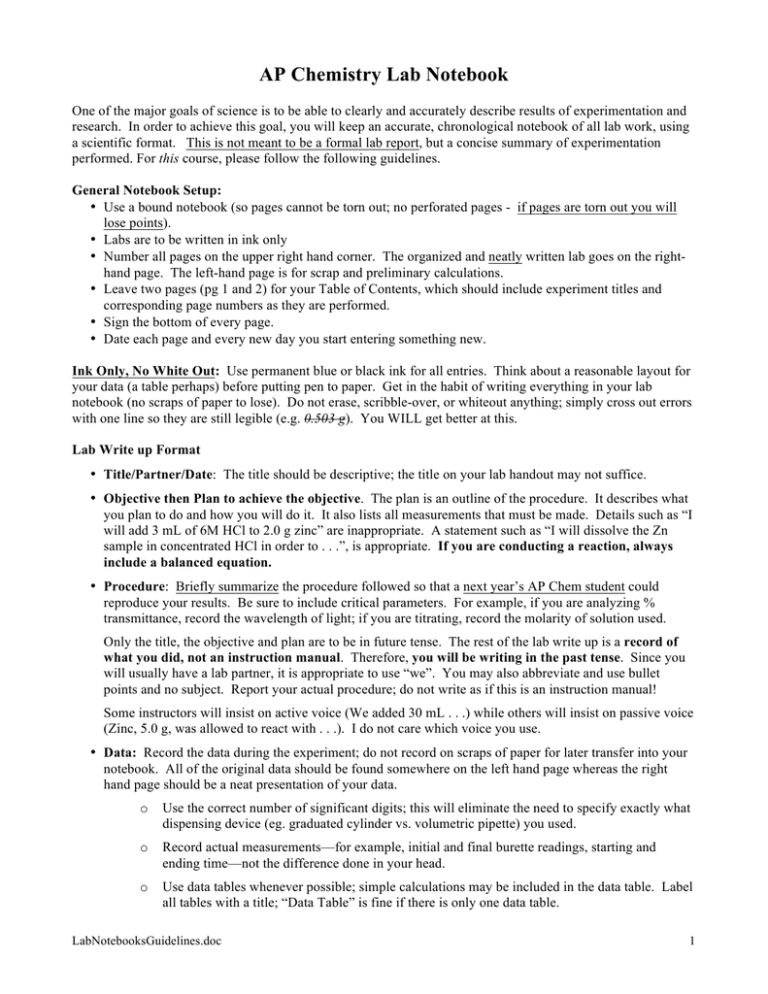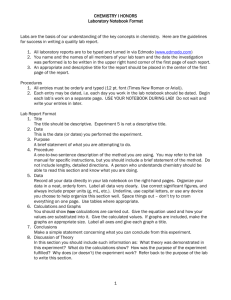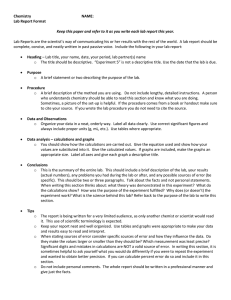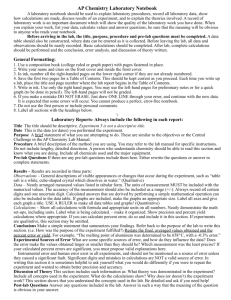AP Chemistry Lab Notebook
advertisement

AP Chemistry Lab Notebook One of the major goals of science is to be able to clearly and accurately describe results of experimentation and research. In order to achieve this goal, you will keep an accurate, chronological notebook of all lab work, using a scientific format. This is not meant to be a formal lab report, but a concise summary of experimentation performed. For this course, please follow the following guidelines. General Notebook Setup: • Use a bound notebook (so pages cannot be torn out; no perforated pages - if pages are torn out you will lose points). • Labs are to be written in ink only • Number all pages on the upper right hand corner. The organized and neatly written lab goes on the righthand page. The left-hand page is for scrap and preliminary calculations. • Leave two pages (pg 1 and 2) for your Table of Contents, which should include experiment titles and corresponding page numbers as they are performed. • Sign the bottom of every page. • Date each page and every new day you start entering something new. Ink Only, No White Out: Use permanent blue or black ink for all entries. Think about a reasonable layout for your data (a table perhaps) before putting pen to paper. Get in the habit of writing everything in your lab notebook (no scraps of paper to lose). Do not erase, scribble-over, or whiteout anything; simply cross out errors with one line so they are still legible (e.g. 0.503 g). You WILL get better at this. Lab Write up Format • Title/Partner/Date: The title should be descriptive; the title on your lab handout may not suffice. • Objective then Plan to achieve the objective. The plan is an outline of the procedure. It describes what you plan to do and how you will do it. It also lists all measurements that must be made. Details such as “I will add 3 mL of 6M HCl to 2.0 g zinc” are inappropriate. A statement such as “I will dissolve the Zn sample in concentrated HCl in order to . . .”, is appropriate. If you are conducting a reaction, always include a balanced equation. • Procedure: Briefly summarize the procedure followed so that a next year’s AP Chem student could reproduce your results. Be sure to include critical parameters. For example, if you are analyzing % transmittance, record the wavelength of light; if you are titrating, record the molarity of solution used. Only the title, the objective and plan are to be in future tense. The rest of the lab write up is a record of what you did, not an instruction manual. Therefore, you will be writing in the past tense. Since you will usually have a lab partner, it is appropriate to use “we”. You may also abbreviate and use bullet points and no subject. Report your actual procedure; do not write as if this is an instruction manual! Some instructors will insist on active voice (We added 30 mL . . .) while others will insist on passive voice (Zinc, 5.0 g, was allowed to react with . . .). I do not care which voice you use. • Data: Record the data during the experiment; do not record on scraps of paper for later transfer into your notebook. All of the original data should be found somewhere on the left hand page whereas the right hand page should be a neat presentation of your data. o Use the correct number of significant digits; this will eliminate the need to specify exactly what dispensing device (eg. graduated cylinder vs. volumetric pipette) you used. o Record actual measurements—for example, initial and final burette readings, starting and ending time—not the difference done in your head. o Use data tables whenever possible; simple calculations may be included in the data table. Label all tables with a title; “Data Table” is fine if there is only one data table. LabNotebooksGuidelines.doc 1 • Observations: Report any observable occurrences (color change, precipitate, gas evolution, heat generation, etc.). • Calculations: Include all pertinent calculations. Calculations of molar mass (e.g. H2O = 2×1.01 + 16.00 = 18.02 g/mol) are not required unless it is an intrinsic part of the experiment. o Label all calculations with a descriptive title. It is not enough to label a calculation with the step number from your lab handout. Include the equation you are using before you plug in the numbers. Use correct sig figs in final answer. Moles of H2 collected n = PV/RT n = (28.9 in Hg)(2.54 cm/in Hg)(1 atm/760 mm Hg)(0.0405 L H2)/(0.0821 L⋅atm/mol⋅K)(298K) For repetitive problems, provide one sample calculation. o SUMMARIZE RESULTS IN A TABLE WHENEVER POSSIBLE. • Graphs: Make graphs an appropriate size so they are clearly legible; all graphs must have a descriptive title. Typically you will show a best fit line or curve; often you will need to calculate the equation of the best fit line. You may draw graphs by hand or paste in a computer-generated graph. You must include a graph, even if you calculated the best fit line by graphing calculator. • Answers to Analysis Questions: These questions are intended to provoke your critical thinking. Be sure to address these questions in the body of your discussion. Do not simply write out the question and answer. If it is a simple lab, you may combine the Analysis and Conclusion sections. • Conclusions: This is where you interpret the data you obtained. What do the calculations/ observations/graphs reveal? What theory was demonstrated? You must have a conclusion, even if it is only 1-2 sentences. Compare your results with accepted values, or with the class average, and list percent error when applicable. State whether your results were too high or too low. Suggest sources of error that would have caused these experimental results. Hypothesize why the errors occurred and what might be changed to avoid these errors. Random error exists in all measurements and should NOT be mentioned. Human error (e.g. spills) and mistakes in recording data are NOT the same as experimental error; usually they are addressed by repeating the experiment. Lab Notebook Grading. AP Chem labs are chosen to aid your understanding of chemical principles, practice manipulation of some typical lab apparatus, and teach you about scientific problem solving. Getting the “right answer” is much less important than understanding why an experimental result is questionable. Discussion with your lab partner is expected. However, everything should be in your own words; graphs must be your own handiwork, not a printout of the same computer `graph. Points may be deducted for wrong answers resulting from lack of preparedness, inattention, or gross sloppiness. Otherwise, see the rubric for grading. Final Note: This is a formal lab presentation. It should be neat. If necessary write a rough draft on a separate piece of paper and then copy it into the lab book. Repeated cross outs and asterisks to add things in late that you forgot will be penalized. If you can not write neatly, print it out from the computer and then paste it into the lab book. LabNotebooksGuidelines.doc 2


